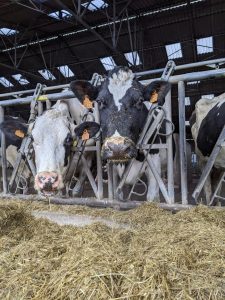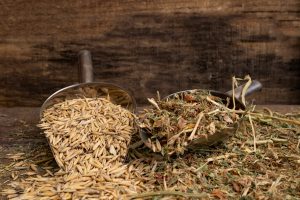Álvaro García
Practical tools that offer multiple uses are rare in dairy production. The handheld refractometer, no bigger than a flashlight and often overlooked, is one of those tools. It’s affordable, easy to use, and provides fast answers that can influence some of the most important decisions you make, whether it’s about feeding a newborn calf, cutting forage for silage, or sending cows out to graze.
A refractometer measures how light bends as it passes through a liquid. On the farm, this is translated into a Brix percentage, which represents the amount of dissolved solids, mostly sugars and proteins, in a liquid sample. The Brix value gives quick insights into energy content, fermentation potential, or protein concentration, depending on what’s being tested. Unlike lab tests that take days, this pocket-sized instrument gives results in seconds and requires only a drop or two of fluid.
You can buy handheld refractometers from most veterinary or farm supply stores, and even online. A simple optical refractometer suitable for forage or colostrum readings may cost around $100 to $150, while digital versions that also estimate serum protein in calves or milk replacer concentration can range from $300 to $600.
From colostrum to calves
One of the most common and impactful uses of a refractometer is measuring colostrum quality. Calves are born without antibodies and depend entirely on the colostrum they receive in the first few hours of life. However, colostrum quality can vary greatly—not all thick-looking colostrum is high in immunoglobulins. By placing a few drops on the refractometer, a farmer can quickly determine its Brix value. A reading above 22 percent is generally considered high-quality colostrum, equivalent to roughly 50 grams per liter of IgG. Colostrum below 18 percent may be best used for second feedings or discarded. This simple reading can guide decisions about freezing, feeding, or supplementing colostrum, helping ensure that each calf gets the start it needs.
Beyond colostrum, the same refractometer can be used to check serum total protein in calves 24 to 48 hours after birth. This is a fast and practical way to confirm whether the calf absorbed enough antibodies through passive transfer. A serum protein reading above 5.5 grams per deciliter—or about 8.4 percent Brix—usually means the calf is protected. Lower values suggest a need for extra monitoring or treatment. Checking even a few calves regularly can help evaluate how well colostrum management is working.
Refractometers also help ensure consistency in milk replacer mixing. Concentrations that are too low or too high can lead to growth problems or digestive upset. A Brix reading between 10 and 12 percent typically corresponds to a standard feeding program, while higher readings are suitable for accelerated plans. For farms with several workers or changing milk replacer products, this test adds peace of mind.
A view from the inside of the refractometer
nD stands for the refractive index at the D-line of sodium (which is a specific wavelength of light: 589 nanometers). It’s a standard reference point used in refractometry. While most farmers use the Brix % scale, the nD scale is still shown on many refractometers. Scientists or lab technicians might use nD for more precise or chemistry-specific applications. On farm, you can ignore the nD reading if you’re just using it for colostrum, milk replacer, or forage testing, Brix % is the number you need.
- 1.000 = the refractive index of air (baseline)
- 1.333 = refractive index of pure water at 20°C
- 1.350–1.370 = typical for liquids with increasing concentrations of dissolved solids (e.g., sugars, proteins)
So, if a liquid has an nD of 1.362, it’s more concentrated (likely higher Brix %) than a liquid with 1.334.
How to check passive transfer using a refractometer
To check if a calf got enough antibodies from colostrum, take a small blood sample 24–48 hours after birth and measure the serum total protein.
Steps:
- Collect blood from the jugular vein using a 20–22-gauge needle and a red-top tube (no anticoagulant).
- Let the sample clot at room temperature for about 30 minutes.
- Separate the serum by centrifuging or refrigerating overnight.
- Place one drop of clear serum on the refractometer.
Read the result:
- ≥8.4€ Brix or ≥5.5 g/dL protein = successful passive transfer.
- Lower= increased disease risk.
Forage and pasture measurements
Silage fermentation depends on the presence of fermentable sugars in the forage. If those sugars are lacking, fermentation may stall, increasing the risk of spoilage and dry matter losses. With a handheld refractometer, a farmer can check sugar levels before ensiling by extracting juice from chopped forage and measuring its Brix value. For corn silage, readings above 7 or 8 percent are usually desirable. Grass and legume forages may need even higher readings—closer to 10 percent or more.
These readings help determine whether it’s the right time to harvest, or whether wilting and inoculants are needed. A poor fermentation can lead to nutrient losses, lower intake, and even health problems in cows. By running a quick Brix test in the field, you can avoid costly mistakes in the bunker or silo.
Pasture management also benefits from this tool. Sugar levels in grasses and legumes rise throughout the day, peaking in the afternoon as plants photosynthesize. By checking Brix values in fresh pasture during different times of the day, farmers can determine the best time to let cows in for grazing. Afternoon grazing, when sugars are highest, may improve energy intake, especially for high-producing cows. Likewise, mowing pastures for silage later in the day can improve fermentation and reduce the need for additives.
Can a refractometer evaluate the effectiveness of an inoculant?
A refractometer can check sugar levels in fresh forage, but when it comes to judging whether your silage inoculant did its job, it has some serious limitations. What it measures is the Brix value, which tells you how much sugar is in the juice of the plant. That’s helpful before chopping—if the Brix is high, say around 10 to 12%, it means there’s plenty of sugar for fermentation. After fermentation, you might see that same forage drop to a Brix of 3 to 5%, which simply tells you the sugars were used up. But it doesn’t tell you who used them! That sugar loss could be from good lactic acid bacteria doing their job, or from spoilage organisms like yeasts and clostridia producing ethanol, butyric acid, or gas instead.
For example, you might compare two bunkers. One started with a Brix of 11% and ended at 4%, and smells pleasantly sour with a pH of 3.9, that’s a good fermentation. But another bunker might also drop from 11% to 4%, yet has a pH of 5.2, smells rancid, and heats up at the face. Same Brix drop, completely different outcomes. The refractometer won’t catch that difference. That’s why it’s important to pair Brix readings with other simple checks: use pH strips or a portable pH meter, smell the silage, feel for heating, and if possible, send a sample to the lab for fermentation acid profiles. In short, the refractometer can show that sugars were present and used, but not whether the inoculant was effective or if the fermentation went the right way.
For all its simplicity, the handheld refractometer supports more accurate, consistent, and profitable decision-making on the farm. It brings clarity to colostrum feeding, calf care, forage management, and milk preparation, all with just a few drops of liquid. Whether you run a small operation or manage thousands of cows, this compact tool delivers insights that make daily choices faster and smarter.
© 2025 Dellait Knowledge Center. All Rights Reserved.









